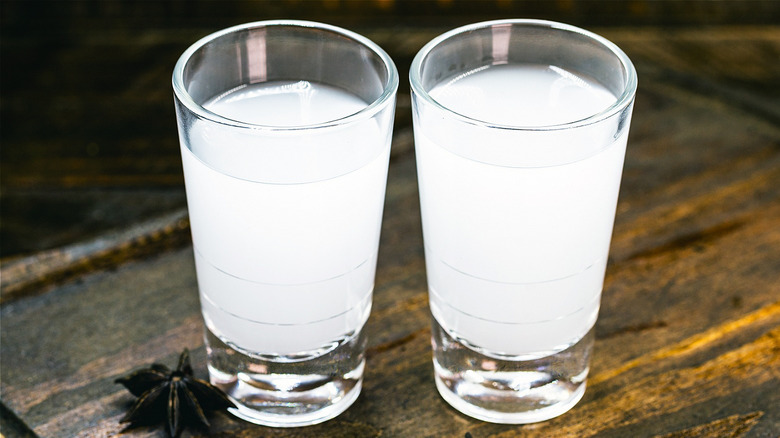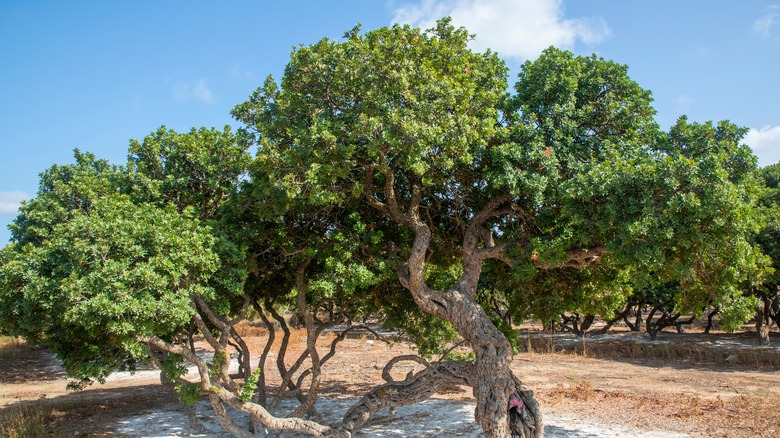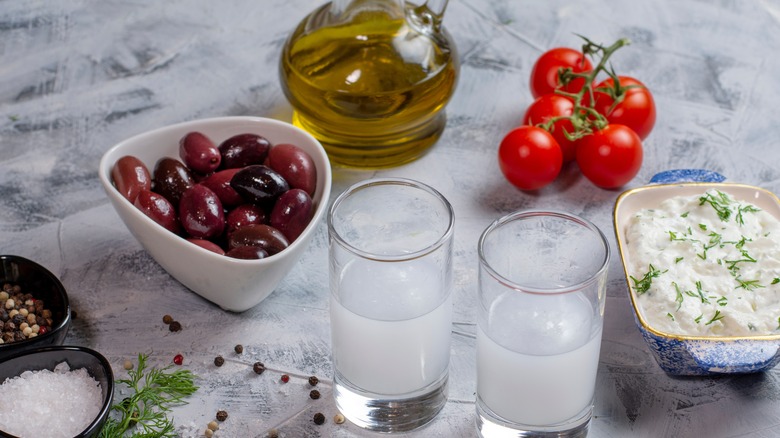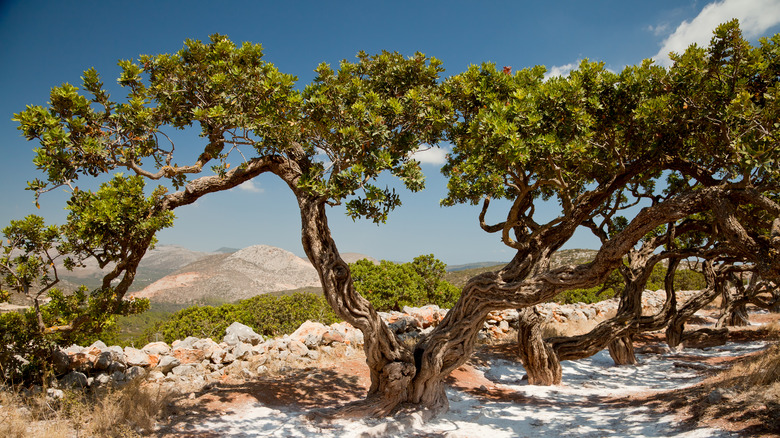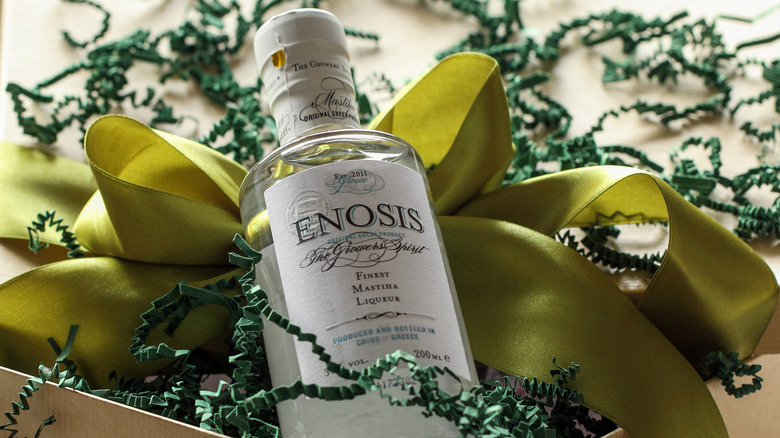What Is Mastika And How Do You Drink It?
Greek cuisine is known for its unique contribution to the Mediterranean diet: juicy spanakopita, savory gyros, and salads of cucumbers and red onions with feta cheese. But the Greek isles are also home to a number of unique liqueurs, including mastika, a drink known for its rich history and unique flavor. Made from the sap of Greek mastic trees, mastika is a milky white liquor with a taste that is reminiscent of pine trees or black licorice. Although mastic trees can be found throughout the region, the ones on the island of Chios in particular are used to make mastika. The island's hot climate allows for the mastic trees to dry out during the summer, and the mastic trees on Chios are the only ones that drip sap when their bark is cut.
The sap was used by the ancient Greeks for medicinal purposes. This was even mentioned by the famed Greek physician and father of modern medicine, Hippocrates, who referred to the sap as mastic tears. Mastic oil was mixed with wine by the ancient Romans, and used by the ancient Egyptians to flavor their water. It was considered a precious resource and was widely traded, required as tribute, or subject to pirate raids. The villages of Chios where mastic grew were heavily fortified by huge walls. To this day there are only 24 villages on the island of Chios, called mastihohoria, where the sap is harvested, and the process is essential to the inhabitants' livelihood and culture.
How Mastika is Made
The start of mastika season begins yearly in July. The sap is collected from mastic trees via cuts that are made in the trees' bark. Every two weeks, new cuts are made in order to encourage the production of more sap. The sap then drips out of the mastic tree and begins to harden on the outside of the tree. The hardened sap is knocked to the ground by farmers, where it further solidifies into round balls or pellets. These are then harvested and cleaned and sorted by hand, and then at a processing plant. The pellets are then finally distilled with alcohol and sugar to create its namesake liquor. Mastic sap is typically harvested between September and October.
While essential, climate conditions are not the only parameters that need to be fulfilled in order to produce mastika. The mastic trees themselves must also meet a specific condition in order to chosen for mastic harvesting: Mastic trees cannot be used to produce mastika until they are at least five years old, though they produce most abundantly at 15 years. Mastika production is officially declared as a protected designation of origin (PDO) by the European Union in order to help preserve this island's agricultural legacy. Though other regions in the area produce a version of Mastika, it is flavored with anise, rather than mastic sap.
How to drink Mastika
You can sip a cold glass of mastika on its own, and it is often enjoyed before a meal as an aperitif or at the end of a meal as a digestif in keeping with its long history of medicinal associations. If you're looking for something to serve after the Greek salad and seafood dishes at a Mediterranean-themed dinner party, mastika is the ideal choice.
While the Greeks typically drink Mastika in the form of a shot, the liquor can also be used in a number of cocktails that highlight the alcohol's unique herbal taste. If you're looking to impress your dinner guests with a unique twist on a classic cocktail, mastika can be used to complement the ginger flavor in a Moscow Mule. Alternatively, try cocktails created specially for mastika like a mastika mojito made with rum and mint, or an Ionian spritz made with sparkling wine. Many mastika-based cocktails feature minimal ingredients, allowing mastika drinkers to appreciate the full range of the liquor's flavor without having it masked by added tastes.
Other Uses for Mastika
While mastika is known mostly for its use as a spirit today, the ancient Greeks used the liqueur for a number of different purposes. Dried mastic sap has been used as a spice since ancient times and can still be found today in traditional breads, meats, and cheeses from the Chios region. Long before mastika was enjoyed by those looking for a stiff drink, the dried sap of mastic trees was prized by the Greeks for its medicinal properties. Mastic sap was traditionally used to ease the pain of stomach ulcers, encourage wound healing, and to remedy oral pain and bad breath. Because of this, mastic sap is said to have been the world's first chewing gum.
Not surprisingly, the liqueur made from the sap also has medicinal benefits, as it contains antioxidants and is anti-microbial and anti-inflammatory. Of course, with an alcohol content of 30% or higher, it's likely that if you drink more than a small glass the benefits might be outweighed by the detriments. A splash of mastika is also often used to flavor soups, sauces, and sweets.
Where to Buy Mastika
If a trip to the Greek island of Chios isn't in the cards, you can still find your own bottle of mastika a little closer to home. While mastika may not be readily available in the spirits section of your local Walmart or Target, you should be able to find it at a well-stocked liquor store. If you'd rather search for mastika in the comfort of your own home, it is also available online. When searching for mastika, it's important to note that a number of different spellings for the liqueur exist, including mastiha and masticha.
Because mastic is only harvested in the very limited region of 24 towns on one island, vast quantities of mastika can't be produced, but there are a few distilleries on Chios that offer the liqueur, all following the traditional methods of harvesting the mastic sap. Mastika from Chios can be found in the price range of $25 to $40 and is considered well worth the price, considering the unique care given to the entire process of its production.
